"It was a geometry book, which he had to hang by strings on the balcony of his apartment in the rue Condamine; the wind had to go through the book, choose its own problems, turn and tear out the pages. Suzanne did a small painting of it, 'Marcel's Unhappy Readymade.' That's all that's left, since the wind tore it up. It amused me to bring the idea of happy and unhappy into readymades, and then the rain, the wind, the pages flying, it was an amusing idea…" (61).
http://www.toutfait.com/unmaking_the_museum/Unhappy%20Readymade.html
**
les Duchamps : combined play, cheating or secrets
MAGDELEINE DUCHAMP (1898- ? )
Magdeleine is 11 years younger than Marcel. We know conspiciuously little about her. She was painted in September 1911 by Marcel “…déchiquetée” and another time in October “A propos…”. On New Year’s Day of 1913 she played along with Marcel’s ‘Erratum musical’. Magdeleine and Yvonne inherit Suzanne’s apartment in 1963. In 1967 they were present at the inauguration of a plaque on the parental house in Rouen.
.
.
YVONNE DUCHAMP (1895- ? )
Yvonne is 8 years younger than Marcel Duchamp. In 1911 painted by Marcel in “…déchiquetée”. She also plays in Marcel’s ‘Erratum musical’ on New Year’s Day 1913. She studies English and Marcel accompanies her for a couple of months while on a language course in England in the summer of 1913. Yvonne Duchamp marries Eugène Alphonse Duvernoy in 1923. They move to Sanary-sur-mer, a seaside resort on the Côte d’azur. In 1947 Suzanne and Crotti pay them a visit.
.
.
SUZANNE DUCHAMP (1889-1963)
Suzanne is 2 years younger than Marcel. She graduates at the Ecole des Beaux-Arts in Rouen (1905). She marries a pharmacist in 1911 whom she divorces in 1913. Her first exhibition is held in the Salon des Independants in 1911, probably thanks to her much older brothers. In 1916 she becomes a Dadaïst. In 1919 she marries the artist Jean Crotti. They both develop a “Style Mecanomorphique” and in 1923 start the “mouvement TABU”. They often exhibit together. Suzanne Duchamp also regularly exhibits in America. In 1923 organised by Katherine Dreier. In 1952 there is the exhibition “Duchamp, frères et soeur” in The Rose Field Gallery, NY. Suzanne Duchamp wasn’t very famous. She hid erotica in her drawings and paintings. So did Jean Crotti.
Intimité(1911, Rouen)From the time of her first marriage. The hidden, erotic drawings have a childlike style. The woman’s blouse is a glans, the hat could be a tongue? The little girl, in her entirety, is an opposite variant to Marcel’s favourite shape, the triangle with the sloped sides. Now seen from Suzanne’s position. Le Cirque(1913, Paris)After her divorce Suzanne moves to Paris, where Marcel lives as well. Do they work together? The entrance to the circus on top of the painting is a glans. In the girl with the balancing stick we see a male profile near a vagina. In addition erections. The lioness is a vagina, the lion a penis. Maybe all of this has to do with their star signs: Marcel is a Lion, Suzanne’s is Libra (Balance). Was this why in their games she was the acrobat hanging in the air while he was the clawing lion on the ground?   
1916 – Suzanne meets Jean Crotti, who came back from New York and brought news about Marcel to the Duchamp family.
1918 – Marcel flees to Argentina. Yvonne Chastel, Crotti’s ex-wife accompanies him. She leaves for Paris as soon as the war is over.
1919 – Marcel travels to Paris and meets Suzanne, now Madame Crotti. He also sees Yvonne again.
1920 – Marcel leaves for New York again to finsih his ‘Grand verre’.
Radiation de Deux Seuls Eloignés(1916-18-20, Paris)This work probably refers to the above mentioned facts. The title has double meanings: The “emission” or “effacing” of two “isolated” individuals or of two “estranged” individuals? A first visual analysis shows (well-known) urine-and-fart situations. But also a bottle of perfume.
 
Only one year later in New York “Belle Haleine” can be admired and Crotti’s ex gets the bottle.
Multiplication brisé et rétabli(1918 – 1919, Paris)About the period just before her marriage to Crotti? The reverse Eiffeltower that we see is really a “Bilboquet”, a ball-catcher. It is still unclear which erotic role this toy was playing. (Marcel gave a wooden bilboquet as a Souvenir de Paris to Max Bergmann in 1910.) In Suzanne’s painting this bilboquet hides an erection, with masturbating hand. The arrow in the painting invites us to a visual game. Holding a mirror to this arrow we see many erotic scenes, something we know from Marcel’s work. But now it is from Suzanne’s viewpoint. In her work we find the same acrobatics: she is kneeling on his shoulders while peeing on his face, Marcel is peeing as well or he ejaculates. The bilboquet shape in combination with the globe-shapes and stars agree with what for Marcel would be a pond of urine between her legs, with bubbling farts? Clearly letters have been hidden as well. But what about the texts? “And the mirror would break, the scaffold would collapse, the balloons would fly away, the stars would fade, etc….” all in the imparfaît. We understand links to her games with Marcel. Games that would disappear. Did they not disappear? Does she still desire Marcel that much? Or did they not disappear with Crotti’s appearance? And even “rétabli”? Do they do the same?  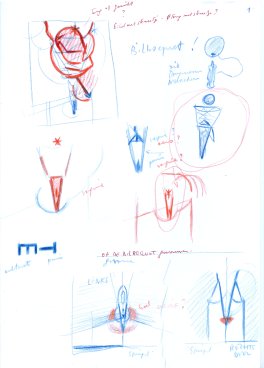   
1919 – Marcel, in Buenos Aires, receives news of Suzanne’s marriage to Jean Crotti. As a wedding gift he sends a maths book: his “Ready-made malheureux”. The book needs to be suspended from a balcony outside so that rain and wind find their own problems in it and tear out those pages. Marcel wants a photo of it.
Seen through their eyes, rain and wind can be… urine and farts. Does Suzanne need to find her urine-and-farts problem, solve it and then destroy it? Or is it Marcel’s urine-and-farts problem that needs to be destroyed?
The ready-made is installed, Marcel gets his photograph. He writes back about the ready-made that is bored on he balcony: “S’il est complètement déchiqueté, vous pouvez le remplacer.” Is she allowed to replace Marcel by Crotti?
Le Ready-made malheureux de Marcel(1921, Paris)Suzanne bases a painting on this picture. Their classical find-the-hidden-erotics puzzle. The profile is not very Marcel-like. And we see a naked breast. For the first time! The breast has a long nipple. It was sucked for a long time, and it certainly was not done by Marcel. The rain-and-wind problem has been ripped out. Marcel is replaced.   Later on Marcel Duchamp will include the picture of his ‘Unhappy Ready-made’ (AS-484) in ‘Boîte-en-valise’. He has touched up the maths book in the picture with a geometrical drawing, like in his 1913 ‘Combat de boxe’ (when he and Suzanne lived in Paris). Here the nose of the profile is in between two circles. These are not breasts but buttocks. The rain-and-wind problem has not been torn out here.
Portrait de Marcel Duchamp(1920, Paris)After her marriage, but drawn earlier than ‘Le ready-made malheureux de Marcel’. Marcel is pictured as a Prince Charming but his shadow is that of a nasty, disgusting person. Portrait and shadow together can form yet another portrait, and a different story. That of an ugly old woman. Maid Clémence? Was she a little deaf? Is that hearing horn hers? Marcel’s eye is mesmerizing. Tilted to the right this eye can be a wide open vagina, it can be a penis, an arse, or the top plan view of a head between legs directed at a vagina. In the middle of the drawing a comic-like profile can be discovered with his nose between buttocks. At the bottom there is a strange, funny cat. Her head is shaped into a reverse “urinal”, or Marcel’s favourite image, seen here from Suzanne’s point of view. Her spread thighs with a penis in front. Probably peeing, filling their pond (see analysis for ‘Red Knight’, AS-427). Differently interpreted the lines show a blowing head between her thighs. Another analysis shows this cat as a devil! This reminds us of the Marcel devil in ‘Obligation pour la roulette de Monte-Carlo’ (AS-406), later on in 1924.  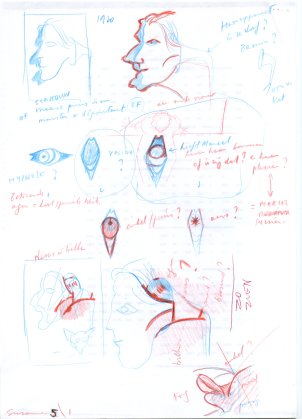  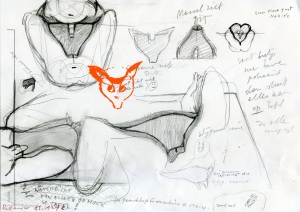
Suzanne Duchamp has continued hiding erotica.
.
.
.
RAYMOND DUCHAMP-VILLON or Raymond Duchamp (1876-1918)
Raymond is 11 years older than Marcel. He started studying medicine in Paris but became a sculptor and changed his name in 1900. He had his first own exhibition in 1902. He marries in 1903. He settles in Puteaux in 1907 where he becomes central to the ‘Puteaux group’. He is important as one of the few cubist sculptors. He went to the front voluntarily to nurse the wounded and died of blood poisoning in 1918 . He never got the chance to extend his oeuvre. He also hid erotica. In particular in ‘Grand Cheval’, for which Marcel Duchamp will supervise an enlargement in 1966.
Grand cheval
(1914)
Raymond applies the classical principle of illusion here: that of “the vase or the hidden faces”. Or the exchange of empty space and tangible volume. This in combination with the sculpted forms result in the same sceneries we know from Marcel: nose near vagina, erection or masturbation, nose near arse… etc.
What is going on with those Duchamps?
.
.
.
.
JACQUES VILLON or Gaston Duchamp (1875-1963)
Gaston Duchamp went to Paris when Marcel was seven. He planned to study law, but in 1895 he changed his name and became an artist instead: Jacques Villon. After the French poet, thief, killer, barroom brawler and vagabond François Villon (1431–1464)and “Jack” by Alphonse Daudet (a very moving social novel tracking the sinister progress of a childhood marred by the lightheartedness of his unworthy mother and and the wickedness of a sadistic stepfather).
In Paris Jacques Villon made engravings, especially the aquatint, and drew cartoons for satirical weeklies. Since 1903 he was co-organiser of the Salon d’Automne. In 1906 he chooses to be a painter and moves to Puteaux, where in 1911 he founds a discussion group of writers and painters that strive for “Lyrical cubism” They organise a lot of salons. He marries in 1913. In that year, during the Armory show in New York, his six contributions are sold. The next years Jacques Villon is relatively successful. In 1923 Marcel Duchamp organises a solo-exhibition of Jacques’ work in NY.
From 1937 Jacques Villon is officially acknowledged. He will receive many international awards. Two exhibitions will be organised of the three Duchamp brothers together: Yale University Art Gallery (1941, New Haven) and Guggenheim Museum (1957, New York). Jacques sells better in America than in Europe. He was the most well-known Duchamp. The works of Jacques Duchamp also contain hidden erotica.
Nos Mécènes(1901)In the caricatures Jacques makes for L’Assiette au Beurre, he hides erotica like Marcel will do seven years later. But not that much in one picture. Here is an erection. And blowing at a vagina? In fact the brothers and sister Duchamp all do the same thing! 
Portrait of Emile Nicole(1891)Jacques is only 16 and portrays his grandfather, who taught him how to draw. In the good old grandpa’s face vaginas and penises are hidden. Exactly like Marcel will do with Dr. Dumouchel (AS- 181) in 1910. 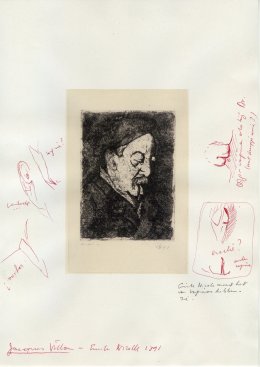 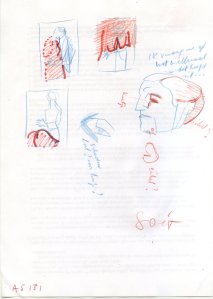 Was the grandfather aware of Jacques’ rigging out? Or did the grandfather teach young Jacques the hiding game? ..
.
.EMILE FREDERIC NICOLLE (1830-1894)
Emile Fréderic Nicolle makes his fortune as a ship broker in Le Havre and Rouen. In 1856 he marries the well-todo Marie Sofie Eugènie Gallet. That year Lucie Nicolle is born: Marcel Duchamp’s mother. Emile Nicolle paints and etches for fun. His first exhibition is in 1864 but his goal is not to sell his works. He keeps them all. Sometimes he will offer one to a family member or a friend. He teaches his grandsons how to draw and gives Gaston (Jacques Villon) an introduction in printing techniques. Emile Nicolle is co-founder of the first picture museum in France: Galerie d’Estampes et d’Histoire Locale.In his work we see, through visual analysis, vaginas. Only the ‘vagina in between the legs”, one in every work. But always. The place of a poplar tree in the landscape, a church tower in a cityscape, or a ship’s mast in the harbour, is always very suggestive. 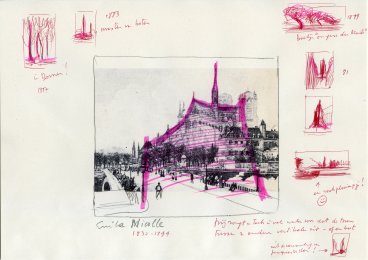 Did the grandfather notice it in the work of Courbet (1819-1877)? Is that why he started doing it as well? Did he teach this to his grandsons and those grandsons to their brother Marcel? And did Marcel teach this to his sister Suzanne? Marcel and Suzanne must have had a lot of fun seeing their big brother’s charicatures in the satirical magazines. Did they see the hidden erections in the ‘Assiette au Beurre’s of 1901? In 1902 teenager Marcel does it himself, a degree higher, with ‘Jeune fille dormante’.
...In number 8 of L’Assiette au Beurre (23.5.1901) Jacques Villon draws a cartoon about a war vet. It is funny that the man looks like father Duchamp. Same eyes, nose and beard, but with more hair on his head. This drawing has a lot of hidden erotic situations and they all refer to masturbation. And we also see how a girl masturbates an adult. A boy does this as well… 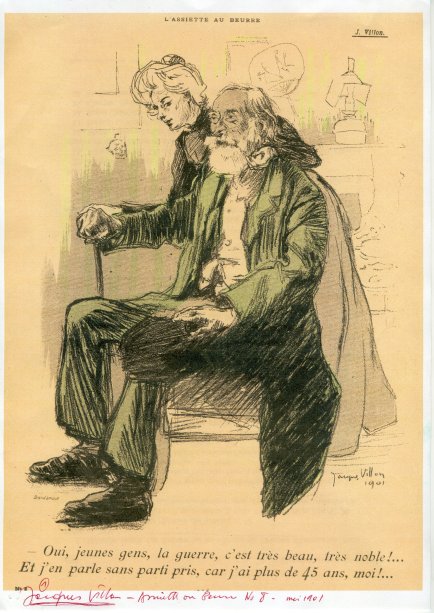  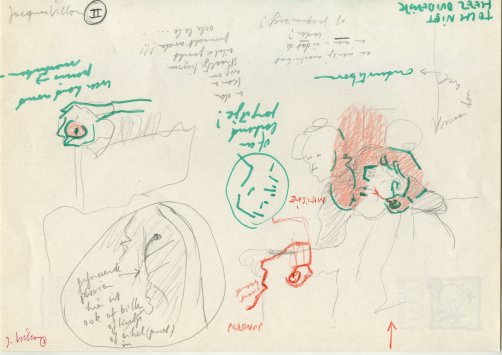 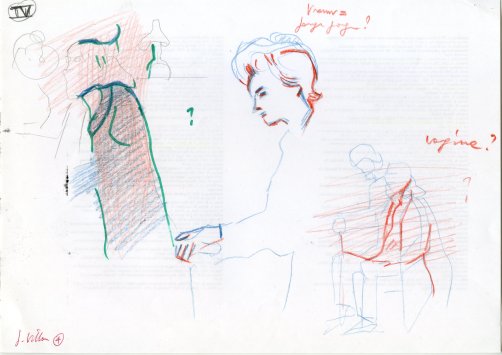 Is this the grown man Jacques? Is big brother doing it to his younger sister and brother? Or is it indeed father Duchamp who forced his sexual desires on his children? That playful father next to Suzanne on the family picture of 1899 (AS-613)? Is this the big secret behind ‘Etant donnés’? Did the father abuse Suzanne? Did he make the hole in her wall…? Quelle famille!
But, do we want to know it all?
Hypotheses… hypotheses…
.
.
.
POSSIBLE SCENARIO part 4 and CONCLUSION
les Duchamps – combined play, cheating or secrets
There are at least 4.071.956 hypotheses about Marcel Duchamp. They are all very interesting. But an intensive, solely visual analysis was never made.
This visual analysis started from the two Keys that Marcel Duchamp gave us: urine and farts. For the first time we were able to see very clearly, black on white, that Marcel Duchamp hid erotica in all his drawings, caricatures, paintings, sculptures and four-dimensional works. And that the erotica is a quite specific one. When the visual analysis also shows us that his sister Suzanne hides the exact same, specific erotica – but from the female position – then we can no longer speak of a coincidence. On top of that we can find in several works of Marcel– also with the help of visual analysis – the words “J’aime Suzanne”. Aren’t we allowed to be a little less hypothetical?
Marcel Duchamp has most certainly had a sexual relationship with his sister Suzanne. They were incredibly in love with each other. At least until Marcel turned 25 in 1912. What a scandal! But the perversities of his acts were even more scandalous. They were a real problem that had to be kept a secret. Most likely there were a few others in on the secret. In any case Duchamp’s family members. But everybody kept nicely silent.
Marcel dealt with his problem in his own way: he cultivated the secret in a visual manner. It meant the problem didn’t exist, neither did the solution to that problem, there was only art. Only his art! Comprehensible only for him, fun only for him. Pure masturbation. Of course others enjoyed it in time. And praised his anti-art, for example. But Duchamp never made anti-art, and never “n’importe quoi”-art. Neither did he make art with a socio-artistic engagement. It was merely always farts and urine, presented four-dimensionally. That was his new contribution to art history: mental art. It was a super-rational art. Every detail was considered thrice. There was a reason and an explanation for everything. Although it was not immediately visible. It was exactly like in chess: the art of the strategy.
Marcel learned the visual hiding and chess playing as a very young boy from his older brothers. They in their turn got it from their grandfather Emile Nicolle. According to this visual analysis the parental house in Blainville must have been filled with the hidden vaginas of gramps. Maybe this is the simple message of ‘Etant donnés’? That “urine-and-farts” was a constant given in the Duchamp’s home. What an example it must have been for our little Marcel. Secretly his grandfather was a hero. But he could do better!
‘Les Duchamps’, the exposition that was organised by Marcel Duchamp in Rouen in 1967, must have been terribly interesting. It was part of his outing. A harbinger of ‘Etant donnés': Jacques, Raymond, Marcel and Suzanne in visual conversation about their urine-and-farts. Was there work of Emile Nicolle? Marcel was indeed the best. He always was the superlative degree. Especially the joyful period of 1913-1923 is one of hyper-creativity, of many great risks and of a passionate pleasure in the game. This is an unparalleled peak in fine arts.
There are a lot of artists showing erotica in a vulgar way. Pornography (explicit eroticism that incites the viewer/reader to masturbate) existed before the invention of the word. The porn industry grows together with the rise of photography, its home base being Paris. Marcel Duchamp does not do pornography, he hides his explicit eroticism. There are of course a lot of artists who hide eroticism as well. They have been around for centuries. Every artist has done it. Because it is fun, an ‘inside joke’. In the early years of photography this was done on a large scale.
In those times a photograph was the new, disappointingly ugly, but true image of reality, as opposed to a drawing or painting, that could beautify reality. Because photography became a competitor, painters would interpret reality, deform it, abstract it and personalize it. Painting is no longer a craft but a completely free art. A lot of ‘-isms’ come into being. Art theory is at its height, as is art philosophy and art criticism. At their height as well are satirical magazines and the caricature. Good illustrators modify reality in a way photography is never able to do. Moreover their modifications are testimony to their intelligence.
And that is what it is about for Marcel Duchamp, playing his hiding games: the intelligence of looking. To show a reality that is not seen. His creativity will go a long way for it.
The whole family Duchamp was into it. Marcels good friend Francis Picabia also played the game sometimes. And Brancusi did. Maybe all of the Puteaux members hid erotica? Maybe that is why they have chosen the name “Lyrical cubism”?
Marcel Duchamp did it in every piece of art. It was his own personal challenge: to show his perverse and disgusting desire in a fresh and original way. No one has seriously investigated that perverse side, because perversity was never taken seriously. Duchamp knew that of course. Who dared put the blame of perversity on him? That person would get the blame right back at him. So everybody kept at a safe distance and did not want to see it, for sure.
Even when Marcel Duchamp reaches out to us posthumously: “Dear friends, it is always and only about 1)the urine and 2)the farts of a woman, you see?”
Maybe this visual analysis has helped a little?
Then we can finally start looking.
.
.
.
.
. . . . . . . . . . . . . . . . . . . . . . . . . . . . . . . . . . . . . . . . . . . . . . . . . . . . .
Ref.: Gorik Lindemans (© 2012)
les Duchamps : combined play. cheating or secrets
1-2-3-DUCHAMP ! a visual analysis of Marcel Duchamponetwothreeduchamp.wordpress.com.
.
| 































